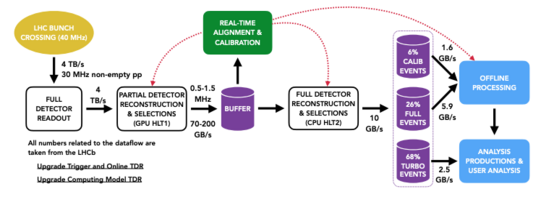LHCb Real-time analysis
The activities of the TU Dortmund LHCb group span across several different topics which are part of the RTA project at the LHCb experiment, CERN. RTA itself stands for real time analysis and is focused onto software development of the LHCb trigger system. ‘Real time’ is the interval between a collision occurring and the point at which the corresponding event must be either discarded forever or sent offline for permanent storage. The LHCb trigger system has the function to decide whether to accept or reject certain events for offline use. This is needed due to the large amount of data that the LHC provides with the proton-proton collision rate of 40 MHz. In order to be able to filter out that many events and to process the large amount of data in the available computing resources, a three-stage trigger system is introduced as shown on the sketch below.

The first stage of the software trigger, the High Level Trigger (HLT1), performs the partial track reconstruction.
A buffer of size 10 PB is placed between the two triggering stages that allows to store events to evaluate the alignment and calibration. Using the online computing farm the alignment and calibration algorithms are evaluated in a few minutes.
Using the alignment and calibration output, the second stage of the software trigger (HLT2) performs a full event reconstruction.
Alignment of the SciFi detector
The alignment estimates the position of detector elements and the correct alignment contributes to improving the data for offline analysis. The real-time alignment and calibration procedure is a fully automatic procedure at the LHCb experiment that is executed at the begining of each fill of the LHC. The procedure is implemented for the full tracking system at LHC including the SciFi detector. Its importance in Run 3 is even more enhanced due to having a fully software trigger at the LHCb experiment. The alignment studies for the SciFi concern estimating the accuracy of the procedure, adapting the alignment algorithms in Run 3 to the detector components and commission the alignment for Run 3. This involves taking part in operational activities of the LHCb experiment to deliver the best quality data.
HLT selections and track reconstruction
Having a fully software trigger in Run 3 the HLT1 stage of the trigger is implemented to run on Graphics Processing Units (GPUs) and our group is involved in developing the track reconstruction algorithms in HLT1 on GPUs.
The beauty physics programme of the LHCb collaboration relies on HLT2 trigger selections to designated signatures. These are devoted to selecting beauty-hadron candidates inclusively, based on the characteristic decay topology and kinematic properties expected from beauty decays and as well selecting them exclusively. We work on the Run 3 implementation of the topological triggers using Lipschitz monotonic neural networks and as well on the inclusive selections of rare-decays. In addition, the selections used for tagging the flavour of the b quark are studied and their performance in Run 3.
The technical aspect of being a member of the RTA research group is work with the LHCb software stack and learn the technicalities about the operation of LHCb using advanced software technologies and machine learning.
A few references to selected publications of the LHCb collaboration regarding RTA:
R Aaij et al. “A comprehensive real-time analysis model at the LHCb experiment”. In: JHEP 14.04 (Apr. 2019), P04006–P04006. DOI: 10.1088/1748-0221/14/04/ p04006. arXiv: 1903.01360. URL: https://doi.org/10.1088/1748-0221/14/04/p04006.
R Aaij et al. “Design and performance of the LHCb trigger and full real-time reconstruction in Run 2 of the LHC”. In: JHEP 14.04 (Apr. 2019), P04013– P04013. DOI: 10.1088/1748-0221/14/04/p04013. arXiv: 1812.10790v2. URL: https://doi.org/10.1088/1748-0221/14/04/p04013.
R. Aaij et al. “Allen: A High-Level Trigger on GPUs for LHCb”. In: Computing and Software for Big Science 4.1 (Apr. 2020), p. 7. ISSN: 2510-2044. DOI: 10.1007/ s41781-020-00039-7. arXiv: 1912.09161v2. URL: https://doi.org/10.1007/s41781-020-00039-7
W.D. Hulsbergen. “The global covariance matrix of tracks fitted with a Kalman filter and an application in detector alignment”. In: Nucl. Instrum. Methods A 600 (2009), pp. 471–477. DOI: 10.1016/j.nima.2008.11.094. arXiv: 0810.2241
T. Kirn. “SciFi – A large scintillating fibre tracker for LHCb”. In: Nucl. Instrum. Meth. A 845 (2017). Ed. by G. Badurek et al., pp. 481–485. DOI: 10.1016/j.nima. 2016.06.057.
L. Calefice et al., “Effect of the high-level trigger for detecting long-lived particles at LHCb”. In: Frontiers in Big Data 5 (2022), DOI:10.3389/fdata.2022.1008737, URL: https://www.frontiersin.org/articles/10.3389/fdata.2022.1008737

